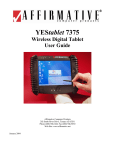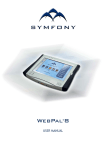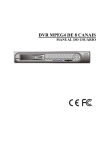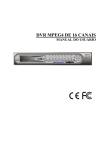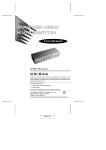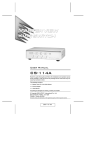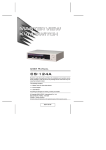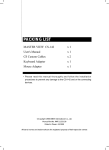Download Affirmative YEStablet 7380 User`s guide
Transcript
® YEStablet Model 7380 USER’S GUIDE Copyright 2003 Affirmative Computer Products® September 2003 YEStablet 7380 User’s Guide September 16, 2003 Front-View Layout Button Functions Button Functions Soft Keyboard “Home” URL Rocker key Sleep mode* Location Left Most Bottom Next to “Soft Keyboard” Right Front Right Edge Side Power off/on Right Edge Side Action Enable/Disable Activate (URL is end-user-configurable) Vertical scroll Manual start/stop – Push/Quick Release of Power Switch Off – Push and Hold power switch for 4 sec. On – Push/Quick Release of Power Switch *Note: You may recover from Sleep mode by tapping on the touch screen or by a Push/Quick Release of the Power Switch. 2 YEStablet 7380 User’s Guide September 16, 2003 Precautions • Do not apply pressure to the display screen. The LCD screen is delicate. • Do not touch the display screen directly with your fingers. You may damage the screen, and oil from your skin may be difficult to remove. Please use the Stylus provided. • Avoid exposing the panel screen to direct sunlight or other heat source. Where possible, the YEStablet 7380 should be facing away from direct lighting to reduce glare. • Do not place anything on top of the YEStablet 7380. • In the unlikely event that smoke, abnormal noise, or strange odor is present, immediately switch the YEStablet 7380 off. Please report the problem to your device provider immediately. • Never remove the rear cover. You will lose any product warranty on the YEStablet 7380. • Always handle your YEStablet 7380 with care when moving it. Package Contents • • • • • YEStablet 7380 (Battery Pack built-in) with Stylus AC/DC Power Adapter Power Cord / USA Type Charging Cradle This document REQUIREMENTS The YEStablet 7380 uses an 802.11b wireless module in a PCMCIA form factor for wireless LAN connectivity. The technology is direct sequencing spread spectrum (DSSS); the carrier frequency is 2.4 GHz and the bandwidth is 11 Mbps. Currently you must have (as basestations) 802.11b wireless Access Points or Gateways with Internet access to adequately evaluate the YEStablet 7380. Other wireless communication protocols will be supported in the near future. Notes in setting up the 802.11b-based wireless communication • The YEStablet 7380 and an 802.11b basestation may work together right out of the box but this will depend on the network environment connected to the access point or gateway. • The ESSID and WEP parameters (if enabled) on the YEStablet 7380 and the basestations have to match. “ANY” for ESSID is universal and is the default for the YEStablet 7380. It is recommended that you change this ESSID to match specifically to your basestation. WEP is “Disabled” as default. • Click on the wireless LAN icon (see below) on the Windows CE Taskbar, to configure the wireless module in the YEStablet 7380. • Refer to the basestation operating manuals for setting up the 802.11b basestations. • NOTE: The wireless LAN icon changes color based on the following: 3 YEStablet 7380 User’s Guide September 16, 2003 OPERATION Power ON and OFF To turn the YEStablet 7380 on, push and quickly release the power switch to the right of the front bezel. The power LED on the YEStablet 7380 will then turn green indicating that the YEStablet 7380 is ready to use. To turn the YEStablet 7380 off, push and hold the power switch for about 4 seconds: the power light and display will go off. A beep will also sound. You can also use soft controls for Power mode and Sleep mode access – use the “Device Shut Down” icon on the TaskBar. Start Up 1. Turn on the power, and after several seconds the Windows CE desktop will be displayed. 2. Choose from any of the displayed icons to activate the corresponding application. Calibration 1. The Calibration Properties screen will appear next if this is a new or reset device. When the YEStablet 7380 prompts you to calibrate the touchscreen, use the Stylus (stored in the upper right surface of the YEStablet 7380) and tap where indicated on the touchscreen in accordance with the instructions. (This document refers to “clicking” or “tapping” interchangeably. The latter is applicable when the touchscreen is utilized). NOTE: You can recalibrate at anytime using either: (1) “Start” “Setting” “Control Panel” “Stylus” or (2) Pressing the Soft Keyboard and E-mail buttons at the same time. Configuring your device 1. Click “Start” on the Windows CE Taskbar, select “Settings”, and then click on “Control panel”. 2. The Control Panel displays several icons associated with utilities for configuring the YEStablet 7380. Many of these are self-explanatory. Some major ones are discussed below. a) Display Quality set up i) Click on “Display”. The Display Properties window will appear. ii) You can use “Brightness” to adjust the brightness of the displayed images. Tap on the left arrow to set the display darker or on the right arrow to increase the brightness. b) Network Configuration i) Double-click on the “Network” icon. ii) Click on “Network”; the Network Configuration will appear. iii) Click on “Adapters”; a list of the network drivers installed on your device will be displayed. Select the adapter that you currently use, then click on “Properties”. iv) You have two options: “Obtain an IP address via DHCP” or “Specify an IP address”. v) When you select “Obtain an IP address via DHCP”, an IP address can be automatically assigned to this device if you have a DHCP server in your network. Then click on “OK” at the top of the window for confirmation. vi) When you select “Specify an IP address”; you have to ask your network administrator for an address and type it in the space provided (IP Address, Subnet Mask, and Default 4 YEStablet 7380 User’s Guide September 16, 2003 Gateway). In addition, you may have to specify additional “WINS” or “DNS” in “Name Servers”. Then click on “OK” at the top of the window for confirmation. vii) Now, you may need to set up a user name, password and Domain. Click “Identification” in Network Configuration window, input your “Name”, “Password” and “Domain”. Windows CE uses the information to identify your right to access the network. Then click “OK” at the top of the window for confirmation. c) Stylus Setup and Calibration i) Double-click “Stylus”; the Stylus Properties window will appear. ii) To test the “Double-Tap” function; follow the instructions to double click the two squares at the right of the Window. If it is correct, then click on “OK” at the top of the window for confirmation. iii) If you want to recalibrate or your device is not responding properly to your taps, select “Calibration” and follow the instruction to recalibrate. When you are done, click on “OK” to continue. d) System Properties Set Up i) Click on “System”; the System Properties window will appear. ii) Click on “General”; the System information will be displayed. Then click on “OK” at the top of the window for confirmation. iii) Click on “Memory”; you can adjust the allocation of unused RAM to run programs or for storage (by moving the arrow to right or left). After changes, click on “OK” at the top of the window for confirmation. iv) The System Properties Set Up procedure is completed. Note: This feature may not be persistent over power cycles. e) System Software Update i) Click on “Update”; the Update window will appear. ii) Provide appropriate information in the blank fields, click “Update”, and the device will be updated with specified software from the specified FTP server automatically. Follow any displayed instructions. After finishing with the loading process, click on “OK” at the top of the window for confirmation f) Operational Tips i) Sometimes an application window may cover the Task Bar. You can recover it by keying Alt+Tab. CAUTION for “Update” Function To avoid system crashes and irrecoverable states, you must: • • Use AC power instead of Battery power when the device software is being updated. NOT turn the system OFF when the device software is being updated. NOTE: It is advisable that you restart the device before performing the Update function, or at least close all opened applications. 5 YEStablet 7380 User’s Guide September 16, 2003 Reading and Sending E-mail You may choose to use the local email client (Inbox) instead of a web-based email solution. 1. Inbox Configuration. i) Open the Inbox program. ii) Go to the Services tab and select “Options”. After you click on “Options”, you will see, in a new window, five tabs: “Services”, “Compose”, “Read”, “Delete” and “Storage”. ii) Select “Services”, click “Add”, and select which type of email service you have, “IMAP” or “POP3”. iii) In the Setup Mail definition (IMAP or POP3) you must provide the information required for“Connection”, “Server”, “User ID”, and “Password”. If you don’t have this information, contact your Network Administrator. iv) Click “Next”. v) In this window you will configure the “Connections Settings”. There are several options -use the default values and click “Next”. vi) The last window is the “Mail Inbox Preferences”. Select the options more suitable to your needs -- you either need to get full copy messages or you want headers only. Note: Files in .TXT, .DOC, .DOT, .RTF, HTML, .GIF and .JPG formats may be read. Accessing the Internet with the Internet Explorer 1. When you want to surf the web, click on “Internet Explorer” in the Desktop screen -- the YEStablet 7380 will display the default web site (for example, MSN). You can change the default web site by using “View” in the menu bar, then Internet Options. 2. If you want to leave the Internet to go to the Windows CE desktop while keeping the web browser open, just “minimize” the browser window. You can click on the Window Taskbar any time to return to the browser and web site. Other Features of Interest • Terminal Clients: ICA and RDP You may use the YEStablet 7380 to connect to Citrix and Microsoft Terminal Servers. (2) “Start” “Programs” “Terminal Client” “Citrix ICA” to connect to a Citrix Terminal Server. (3) “Start” “Programs” “Terminal Client” “Microsoft RDP” to connect to a Microsoft Terminal Server. • JVM: Java Virtual Machine. This allows you to view and access Java-based applets and applications. • PDF Document Viewer. 6 YEStablet 7380 User’s Guide September 16, 2003 • Multi-Format Document Viewer. • Macromedia Flash 4.0. • Inking. Write messages or take notes using the touch screen for records or for transmittal via e-mail as attachments. • Local Printing Support (EPSON USB Printers only). Use the USB port on the YEStablet 7380. It is recommended that the YEStablet 7380 be powered externally for local printing. • Network Printing Support (EPSON Parallel/USB and HP PCL Shared Printer). Print off of shared PC printers (Print function in browser and other Applications). • IP Configuration Utility. You may view your assigned IP address or change it. (1) “Start” “Programs” “IP Config” to view your IP address or change it. • Signal Strength Indicator You can view the signal strength and link quality between your YEStablet and the nearest wireless access point by clicking on the lightning bolt icon in the system tray. This brings up a “Wireless LAN Settings” sub-window. Click on the Link tab to see the indicators. • Charging Cradle. You may charge your YEStablet 7380, with the AC-DC adapter provided, directly or with the AC-DC adapter through the charging cradle. • Reset button. You may perform a reset to the YEStablet 7380 in the unlikely event of device lock-up. The reset button is located in a recess cavity on the back cover of the YEStablet 7380. Push on the button with a thin cylindrical object to activate the reset. The device will be turned off and you will need to restart the device. This reset will NOT clear your software settings and saved information. 7 YEStablet 7380 User’s Guide September 16, 2003 Emulator Session Configuration Double-click on the desktop YESterm IP icon to open the Administrator. After choosing either a YESterm IP display or a YESterm IP printer emulation, a wizard will guide you through configuration. You can have a maximum of four emulation sessions. See the YESterm/IP_CE User Guide for details YESterm IP Display 1. Host Name/IP Address: If you have a local DNS or WINS server, you can type in the AS/400 host network name. Otherwise, type in the IP address of the AS/400 server. 2. Port Number: Use the default of 23 3. Connection Name: This is the friendly name that will appear in the Connection Manager screen. 4. Device Type: Select one from the drop-down list. The default 3477-FC works well unless you have special needs. 5. Device Name: If you are using named sessions, enter the session name here. 6. Host Code Page: Choose the applicable country from the drop-down list. 7. Keyboard Type: Choose 101 Terminal if you are familiar with a terminal keyboard layout. Otherwise, choose 101 PC. This concludes the display configuration parameters covered by the wizard. However, highlighting the connection name in the Administrator and clicking on Edit can configure many more parameters. Choices for many of these parameters are self-explanatory, but here are explanations for some of the less-obvious choices. • • • • • • • • • Connection: If you wish to use sign-on encryption, choose an appropriate encryption level here. Your AS/400 must also be configured for this encryption level. General: The upper Edit button allows changes in the standard EBCDIC-to-ASCII conversion table. The lower Edit button invokes the keyboard map editor. The default maps match the commands and characters to the command and character nomenclatures on the keyboards. If you wish to make command changes from the default, use this editor. The modified map will replace the default map, so any new session that uses the same type of keyboard and the same keyboard language locale will also have the same modified map. Terminal Enter. On a 101-key keyboard with a terminal layout, the terminal Enter key is the PC RightCtrl key. However, the virtual keyboard in the YEStablet does not have this key. Therefore, a useful alternative is to map the End key to terminal Enter. In the YESterm IP keyboard map editor, this is seen in the keyboard graphic as the NumPad Enter key. Your YEStablet typically comes with this key already mapped to terminal Enter. Terminal Reset. On a 101-key keyboard with either a terminal or a PC layout, the terminal Reset key is the PC LeftCtrl key. Attributes: If you don’t like the colors in your session, change them here. Column separator characteristics can also be changed here. Hot Spots: You can change the command assignments for global hot spots, or you can define new hot spots Key Pad: You can change the command assignments, add new buttons, or remove buttons. Sign On: Enter your sign-on information here if you are using sign-on encryption. Advanced: Choose between a pure green-screen text display mode and a Windows display mode with menu, tool bar, and graphics status line. Acoustic messages, typically error beeps, can be assigned to the terminal’s internal speaker or to external speakers (wave device). 8 YEStablet 7380 User’s Guide September 16, 2003 YESterm IP Printer 1. Host Name/IP Address: If you have a local DNS or WINS server, you can type in the AS/400 host network name. Otherwise, type in the IP address of the AS/400 server. 2. Port Number: Use the default of 23 3. Connection Name: This is the friendly name that will appear in the Connection Manager screen. 4. Device Type: Only 3812 is available for TCP/IP devices. 5. Device Name: If you are using named sessions, enter the session name here. 6. Host Code Page: Choose the applicable country from the drop-down list. This concludes the printer configuration parameters covered by the wizard. However, many more parameters can be configured by highlighting the connection name in the Configure tab of Connection Manager and clicking on Edit. Choices for many of these properties are self-explanatory, but here are explanations for some of the less-obvious properties and choices. • Connection: If you wish to encrypt your print stream, choose an appropriate encryption level here. Your AS/400 must also be configured for this encryption level. • Output: Set your printer response timeout period here. Select LAN Printer as your Output Port (this is the only one that works) and configure it here. • Advanced: If you wish to use Host Print Transform, configure it here. SUPPORT Call Affirmative Computer Products toll-free at 888-353-5250 or send email to [email protected]. 9 YEStablet 7380 User’s Guide September 16, 2003 APPENDIX: EXTERNAL COMPACTFLASH (CF) SLOT This section discusses the use of the external CF slot located along the left edge of the YEStablet 7380. The CF slot is characterized by an opening to insert a CF card next to an ejector button. When a CF card is inserted into an empty slot, the ejector button will protrude. Pushing on this protruded button will eject the inserted card. The CF slot is designed in the YEStablet 7380 to provide storage for email attachments, file downloads, external (Windows CE-compatible) applications, etc. It is designated as "EXT CF Card" in the file structure of the Windows CE device. To display the contents of the inserted CF card, select My Computer->EXT CF Card. This is in contrast with "FlashStorage" (My Computer->FlashStorage), which is a dedicated storage partition in the internal flash memory of the YEStablet 7380. IMPORTANT Precautions when using the CF slot: (A) It is advisable that an external CF card be plugged into the External CF Slot before powering ON the device. Similarly it is advisable to power OFF the YEStablet 7380 before extracting the external CF card. (B) The external CF card may be inserted or extracted without power cycling the YEStablet 7380 IF the following guidelines are strictly adhered to: After inserting the CF card, invoke the CF Card Manager (Icon on the Windows CE Desktop) and select ATTACH. (You may wish to select DETACH before inserting the card in case the slot had not been properly detached previously.) To remove the CF card, invoke the CF Card Manager (Icon on the Windows CE Desktop) and select DETACH. Remove the card only after the acknowledgment message box is displayed. CAUTION: Adhering to the above guidelines will help avoid the loss or corruption of information on the internal and external flash memories. The manufacturer is not responsible of lost data associated with the use of the external CF card slot. The external CF slot is expected to be compatible with a variety of CF cards from different manufacturers. However the following brands are currently qualified for use with the YEStablet 7380. Brand Apacer (www.apacer.com) Sandisk (www.sandisk.com) Capacity 16MB – 256MB 16MB – 128MB 10 Manufacturer P/N AP-CF01611 to AP-CF25611 SDCFB-32-455 to SDCFB-128-455










